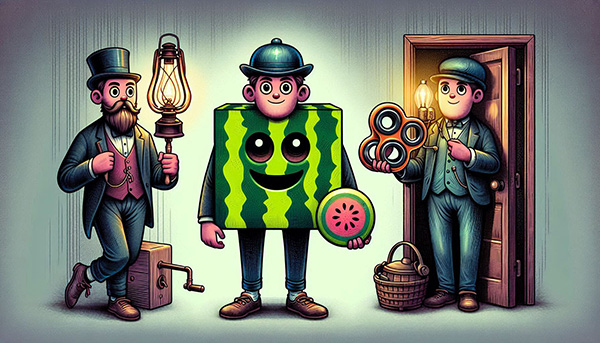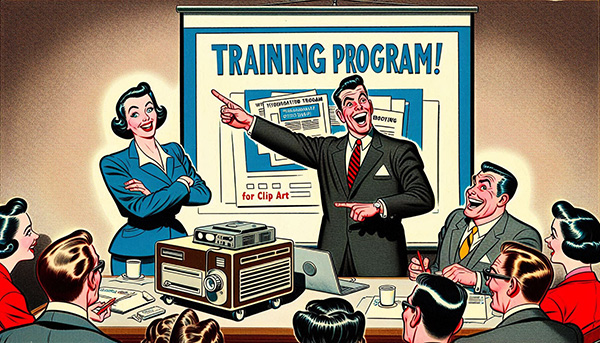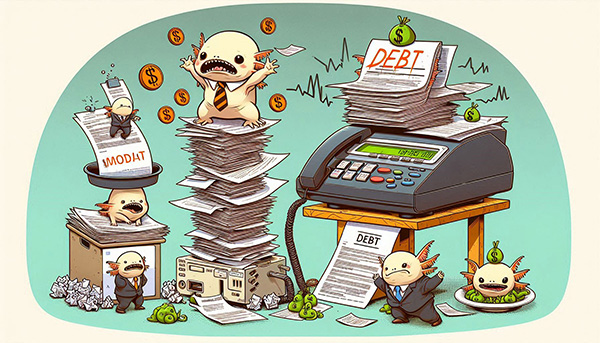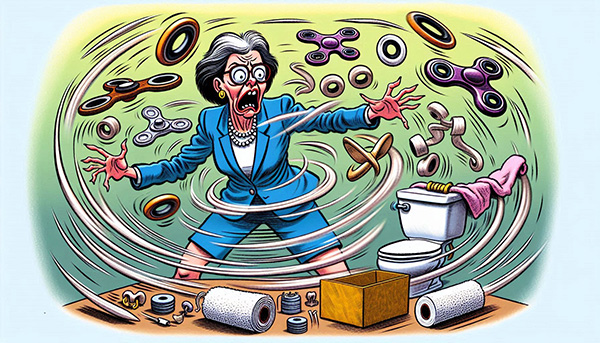By: John S. Morlu II, CPA
Every year, the government unleashes a tidal wave of taxpayer money—billions, yes, billions with a B—into small business training programs, all under the grandiose banner of nurturing the next generation of visionary entrepreneurs. Imagine this: a cascade of funds directed toward ambitious initiatives like “How to Launch a Hotdog Stand (While Chasing Your Dreams!)” and “Bootstrapping Your Social Media Empire in Five Simple Steps.” With such a torrent of support, one would think that small business failure rates would be crashing through the floor, while success stories and innovative triumphs soared to unprecedented heights. But here’s the kicker: about 75% of these ambitious startups will face the cruel reality of failure within just five years. And, astonishingly, the clock can tick even faster if their entrepreneurial brilliance includes the sale of square watermelons (yes, we’ll get to that curious case shortly).
Instead of guiding hopeful entrepreneurs toward the bright shores of success, these government programs seem to have mastered a different art altogether—one of producing systematic entrepreneurial failure. Even the most diminutive villages, like Whistling Pines (population: 237, plus one suspiciously large cat), allocate precious budgets for small business growth, entrepreneurial workshops, and “mentorship”—an initiative fondly term the “Great Taxpayer Giveaway.”
In this exploration, we’ll embark on a satirical voyage through the landscape of fictional yet eerily relatable small businesses. We’ll delve into the absurdities of government-backed training programs, peel back layers of bureaucratic bewilderment, and reveal the startling, often hilarious truths behind why these well-meaning programs might be more Titanic than Shark Tank. Prepare yourself for a whirlwind of humor, irony, and biting satire as we unravel the story of how even the most well-intentioned bureaucratic support can drive countless small ventures straight into the icy waters of failure. Buckle up—this ride promises to be as enlightening as it is entertaining.
Chapter 1: Meet Our Small Business Heroes
Welcome to the whimsical world of small business heroes, where dreams are as grand as the lessons in “what not to do.” Allow me to introduce you to our trio of entrepreneurial legends, whose ventures are as unique as their stories are instructive.
First up, we have Carl “I Don’t Need A Business Plan” Jenkins, the visionary behind Carl’s Custom Watermelons. Carl’s enterprise is so niche that even the watermelon industry is scratching its head in bewilderment. Fueled by the grandeur of the government-sponsored course “Mastering Supply Chains for Perishable Foods,” hosted by the illustrious Whistling Pines Village Council’s “Economic Empowerment Initiative,” Carl embarked on a mission to revolutionize fruit. His groundbreaking idea? Square watermelons—because apparently, fruit that doesn’t fit neatly into refrigerators is the crisis of our time.
Carl, undeterred by the giggles of industry experts and the questionable practicality of his endeavor, invested every last cent of his government grant into his geometric fruit venture. His grand vision? To reshape fruit in a way that would, ironically, reshape his life into a series of spectacularly squashed failures. Despite the enthusiastic encouragement from his local council (which clearly had too much time and too few successful businesses to support), Carl’s dream of square watermelons rolled downhill, leaving him with a bounty of oddly shaped fruit and a financial mess that could only be rivaled by the Great Depression.
Next on our roster of entrepreneurial legends is Larry “I Think I’m on to Something” Jenkins, the proud owner of Larry’s Lamp Emporium. Larry’s story is a shining example of how a lack of market research can lead to bright ideas that don’t quite illuminate the path to success. With a population of 39 and an even smaller customer base that didn’t use electricity, Larry’s lamps were destined for a rather dim fate. Despite the town’s annual allocation of $15,000 to their “Small Business Revival Fund” and the mantra “Empowering You to Open a Store That Will Fail Elegantly,” Larry learned the hard way that kerosene lamps weren’t the future. “Turns out kerosene lamps aren’t the future,” Larry lamented, after taking a course titled “Diversifying Product Lines with Eco-Friendly Solutions.”
And then there’s Daisy “I’ve Got This” Thompson, who boldly launched Daisy’s Designer Doorknobs after attending a whirlwind five-day seminar on “The Art of the Pivot,” courtesy of the Big City Downtown Business Incubator (a.k.a. the three-person business committee from the neighboring town of Dandelion Junction). Daisy’s claim to fame? Doorknobs that double as fidget spinners. “It’s functional and fun,” Daisy enthused at her launch party—a modest affair featuring her cat, a bemused town council representative, and two pigeons that, in a shocking turn of events, devoured most of the complimentary croissants.
Daisy’s inventive approach to home hardware had all the makings of a viral sensation—if only the world were ready for doorknobs that spin. Her entrepreneurial venture, buoyed by the optimism of “Founders’ Fury Workshops” and “BizBoost Bonanza” programs, was guided by a six-minute video and a free downloadable PDF. The sage advice contained therein was as profound as it was practical: “Remember to sell stuff.” Armed with this wisdom, Daisy’s launch party was a hit—well, at least in the annals of pigeon history.
Together, Carl, Larry, and Daisy embarked on their entrepreneurial journeys with dreams as grand as the names of their government-backed training programs. They were the proud recipients of advice so specialized it could only be described as generic, delivered through PDFs that rivaled ancient scrolls in their obsolescence. As we dive into their tales of glory and woe, we’ll explore how government intervention, with its delightfully misguided programs, often transforms well-intentioned business plans into cautionary tales.
So buckle up and prepare to laugh, cringe, and marvel at the boundless creativity and inevitable mishaps of our small business heroes. This is the stage where bureaucratic ambition meets entrepreneurial naiveté—a truly entertaining spectacle where the only certainty is that hilarity will ensue.
Chapter 2: The Birth of Government Programs for Small Businesses: How Did We Get Here?
The U.S. government has harbored a deep-seated fascination with small business success for decades—an obsession that took root back in the 1950s. At that time, a bunch of well-meaning bureaucrats looked around and thought, “You know what the world needs? More PowerPoint presentations!” Thus, government-sponsored training programs were born, bursting onto the scene with the zeal of a thousand clip-art graphics and an insatiable appetite for taxpayer dollars.
As the idea snowballed, local councils, even in the most minuscule of towns, jumped on the bandwagon. Take Elk’s Puddle, for example—a town with a population so small, the town council meetings are held around the kitchen table of the mayor’s cat. Here, the council generously allocated $15,000 annually to their “Small Business Revival Fund.” Their official slogan? “Empowering You to Open a Store That Will Fail Elegantly.” The sheer poetry of it! It’s as if they’ve embraced failure as an art form, ensuring that each business collapse is as graceful as a swan dive.
Among the dreamers was Larry, the enthusiastic proprietor of Larry’s Lamp Emporium. Larry, with visions of becoming the next big thing in illumination, applied for a grant and eagerly attended the council’s course on “Diversifying Product Lines with Eco-Friendly Solutions.” Armed with the latest knowledge in green lighting, Larry set out to conquer the market. There was just one tiny snag: his entire customer base was made up of people who didn’t use electricity.
Turns out, the kerosene lamp industry might not be the future after all. “I thought I was on the cutting edge of innovation,” Larry lamented, his dreams flickering like a dying candle. “But I guess the future doesn’t have much use for lighting that requires a match.” Larry’s epic quest for success, as inspired by the council’s profound advice, ended up illuminating just how much kerosene lamps are… well, a bit out of place in a world powered by electricity.
Elk’s Puddle wasn’t alone in its grand ambitions. Small towns nationwide embraced similar programs with the fervor of a new fad diet. The “BizBoost Bonanza” workshops promised to turn every participant into a business guru—while simultaneously teaching them to play a ukulele. The “Founders’ Fury Workshops” offered priceless insights like “Use Social Media” without specifying which platforms or how to avoid accidentally going viral for all the wrong reasons.
As these programs sprouted like weeds, the world was introduced to a new wave of entrepreneurs who were prepared to tackle the market with the sort of ideas that could only be described as… unique. Our government’s well-intentioned interventions, meant to nurture and support, have instead provided a delightful array of cautionary tales.
From Elk’s Puddle to bustling metropolitan areas, the government’s quest to foster small business success often resulted in charmingly misguided ventures. So, as we navigate the labyrinth of these programs, let’s tip our hats to the bureaucrats who believed that with the right presentation, any business idea—no matter how whimsical—could be a smashing success. After all, if we can’t have successful businesses, we might as well enjoy the sheer absurdity of the journey.
Chapter 3: The Government’s Course Catalog: An Embarrassment of Riches
If you’ve ever wondered what happens when bureaucrats with too much time on their hands and an overabundance of grant money collide, look no further than the bewildering smorgasbord of training programs offered by government agencies. These courses are as diverse as they are confounding, ranging from practical to profoundly perplexing. Prepare to dive into this kaleidoscope of entrepreneurial wisdom:
1. “Accounting Basics for Businesses That Don’t Make Money Yet”
- Offered by: The Department of Predictably Low Revenue
- Course Description: This gem aims to teach hopeful entrepreneurs how to balance their books when the only item on their ledger is “debt.” Carl Jenkins, ever the optimist, enrolled in this course to figure out how to classify his square watermelons as both an asset and a liability. It turned out to be eerily accurate—his inventory was as squarely in debt as his balance sheet. Apparently, being “in the black” was a distant dream for Carl’s geometric fruit venture.
2. “Customer Service in the Digital Age (But Let’s Ignore Social Media)”
- Offered by: An Instructor Who Still Nostalgically Refers to the Internet as “The Information Superhighway”
- Course Description: Dedicated to handling customer complaints via the venerable fax machine, this course is a trip down technological memory lane. Daisy Thompson, ever the trendsetter, now proudly displays a “Fax Us Your Complaints” sign in her doorknob shop window. So far, no one has faxed her—a fact she optimistically interprets as flawless customer satisfaction. Or maybe just a lack of faxes. Either way, her customer feedback loop is remarkably quiet.
3. “How to Qualify for Government Grants: Fake It ‘Til You Make It”
- Offered by: The Tiny Town Economic Rescue Coalition in Pinecone Valley
- Course Description: This program encourages entrepreneurs to dream up any harebrained scheme that could justify a grant application. The result? An eclectic mix of businesses, including Cat Wedding Planners (because every feline deserves a grand ceremony) and Vegan Axolotl Snacks (because no axolotl should suffer the indignity of a carnivorous diet). It’s a carnival of entrepreneurial oddities where the only limit is your imagination—and perhaps your sense of reality.
4. “Marketing in a Post-Print Era”
- Offered by: The Grand Old Advertising Association of Yesterday
- Course Description: Despite the digital age screaming from every screen, this course continues to champion the glory of yellow pages ads and billboards. Carl Jenkins, ever the visionary, chose to advertise his square watermelons with a billboard boasting, “Square Watermelons: A Better Way to Be Confused.” He hoped the irony would attract hipsters looking for something ironically quirky. Sadly, the billboard’s message was lost on everyone except passing cows, who seemed only mildly intrigued by the spectacle.
5. “How to Write a Press Release That No One Will Read”
- Offered by: The Bureau of Media Irrelevance
- Course Description: This course provides a step-by-step guide on crafting the perfect press release for newspapers that haven’t been in print since the Clinton administration. Daisy Thompson took this course to promote her fidget-spinner-doorknob hybrid. She eagerly sent her press release to The Weekly Bulletin, only to discover that the paper had folded—both literally and figuratively—two decades ago.
These courses, with their charmingly outdated and occasionally absurd content, are a testament to the government’s earnest—but often misguided—attempts to foster small business success. They offer a rich tapestry of entrepreneurial training that can only be described as both hilariously inept and endearingly earnest. As we navigate through the landscape of these programs, it becomes clear that while the intentions might be good, the results often veer into the realm of the absurdly comic. So buckle up and enjoy the ride through this treasure trove of bureaucratic brilliance—or lack thereof.
Chapter 4: Fun Fact: The “Strategic Pivot”—Or How to Overthink Your Business
In the ever-evolving world of government-sponsored business training, one buzzword reigns supreme: the “strategic pivot.” This concept, stolen straight from the hallowed halls of Silicon Valley, promises to turn business woes into wondrous success. Picture it: the secret sauce for overcoming entrepreneurial stagnation! But here’s the catch—what works for tech startups doesn’t always translate smoothly into the world of non-tech ventures. Enter Daisy Thompson and her wild, whirlwind journey through the strategic pivot.
Daisy started her entrepreneurial adventure with an elegant twist—designer doorknobs. These were no ordinary knobs; they were fidget spinners disguised as home decor, a marvel of multi-tasking! But when the fidget spinner craze fizzled faster than a soda in the desert, Daisy pivoted. “No worries!” she declared with the confidence of a seasoned innovator. Next up? Ergonomic toilet seat handles. Because, according to her seminar, “bathroom comfort is the new frontier.”
One might think that ergonomic toilet seat handles would be a revolutionary leap forward, but alas, the public’s enthusiasm was lukewarm—at best. So, undeterred by yet another setback, Daisy pivoted again, this time into the world of artisanal lint rollers. Yes, you heard that right. Not just any lint rollers, mind you, but ones with customizable patterns! “Because every lint roller should be a statement piece,” Daisy proclaimed with a straight face.
Despite the impressive array of pivots, Daisy’s latest venture is a charmingly eclectic mix of patterns and practicality. From paisley prints to avant-garde abstract designs, her lint rollers are a veritable gallery of household essentials. It’s as if Daisy has taken the concept of the strategic pivot and turned it into a full-blown art form—complete with an endless loop of reinvention.
Now, let’s dive into the numbers. One of the seminars Daisy attended promised that strategic pivoting would increase success rates by 48%. Sounds impressive, right? But there’s a small detail that might make you chuckle—this figure came from a survey of precisely three companies, one of which was a lemonade stand run by a particularly ambitious 10-year-old. So, while Daisy’s pivots might be driven by the promise of exponential success, the reality is that the statistical backing is as flimsy as a house of cards.
The pivoting phenomenon is an entrepreneurial goldmine of overthinking. It’s like taking a map of your business and deciding to explore every possible route—regardless of whether they lead to dead ends or enchanted forests. Each new direction promises salvation, but more often than not, it ends in a series of amusing misadventures.
In the grand theater of strategic pivots, Daisy Thompson is a shining star of versatility—or at least she’s convinced she is. Her journey is a testament to the high-wire act of entrepreneurship, where every misstep is a new opportunity for reinvention. And while the strategic pivot might have promised a golden ticket to success, it seems Daisy’s true achievement lies in her unflagging spirit and a penchant for creating ever more whimsical products.
So here’s to the art of pivoting—a strategy that’s as flexible as it is fantastically baffling. It’s a reminder that while the road to success might be paved with good intentions and strategic realignments, sometimes it’s the sheer unpredictability of the journey that makes the adventure truly worthwhile.
Chapter 5: Where Did the Money Go?
So, we’ve established that the government is pouring billions into small business training programs, but the real mystery is: where does all that money go? Let’s embark on a humorous tour through the labyrinthine world of bureaucratic spending and discover just how your hard-earned taxpayer dollars are being spent.
First up, let’s talk about the glossy brochures. These marvels of modern design, often printed on paper so shiny it could double as a mirror, sport slogans like “If You Dream It, You Can Fund It… Maybe” and “Maximize Your Potential Without Maximizing Debt (LOL).” These brochures are designed to inspire, or at least to make you think that someone somewhere is really, really trying to help. They’re often distributed in coffee shops, libraries, and anywhere people are likely to glance at a flyer before tossing it into the recycling bin.
Then we have the training videos. These cinematic masterpieces are usually filmed in a conference room that looks like it hasn’t been updated since the invention of the fax machine. The instructor, who seems to have emerged from a time capsule marked “2003,” delivers lectures with the enthusiasm of a sloth on a sedative. Fun fact: 62% of these videos feature stock footage of overly enthusiastic people shaking hands. You know the type—their smiles so wide they could probably eat a watermelon whole, square or not.
The online forums are another gem in the treasure trove of government-sponsored training. These forums are where small business owners can pose their burning questions, such as “Why won’t my business idea work?” and receive responses that are as enlightening as they are unhelpful. Common answers include gems like, “Have you tried working harder?” and “Maybe consider more social media.” It’s like the digital equivalent of shrugging and saying, “Good luck with that.”
And let’s not overlook the pièce de résistance: Small Business Saturday. This brilliant initiative, championed by village councils across the nation, encourages local businesses to offer discounts. The catch? Small Business Saturday often coincides with the town’s annual Tractor Parade, which, as you might guess, is a day when the entire town is closed for festivities celebrating farm machinery. It’s the perfect time for local businesses to shine—if only the entire town wasn’t out on the streets waving at tractors.
In tiny towns like Elk’s Puddle and Whistling Pines, this budgetary ballet reaches its peak. For instance, Elk’s Puddle, with its 39 residents, spends a considerable amount on a “Small Business Revival Fund.” The town’s official slogan, “Empowering You to Open a Store That Will Fail Elegantly,” is printed on every flyer, hoping to instill a sense of poetic grandeur in every failed venture.
Meanwhile, Whistling Pines, with its population of 237 and one mysteriously oversized cat, hosts monthly “Entrepreneurial Enrichment Days.” These events include seminars on how to capitalize on niche markets, like creating artisanal soap for people with extraordinarily specific preferences. Attendees are treated to free refreshments, which consist of three stale donuts and a pitcher of lukewarm coffee, because nothing says “inspiration” quite like underwhelming refreshments.
As for the funds allocated to these grand endeavors, they often flow into well-intentioned but ultimately unremarkable projects. There’s the “BizBoost Bonanza” seminar series, which promises to transform any business idea into a success story but usually results in attendees discovering new ways to question their life choices. Or consider the “Founders’ Fury Workshops,” which offer advice such as “Just keep going” and “If at first, you don’t succeed, pivot to something else that’s equally doomed.”
So, where does all the money go? Into the swirling vortex of glossy brochures, outdated training videos, and online forums with answers as useful as a chocolate teapot. It’s a whimsical dance of bureaucratic inefficiency, where every dollar spent is a testament to the creativity of public spending. And while the results might be less “Shark Tank” and more “Lost in Translation,” one thing is certain: the government is determined to ensure that every small business owner has a well-stocked arsenal of motivational posters and stock footage to guide them on their journey.
In the grand theater of government-sponsored business training, the performance might be a bit tragicomic, but at least it provides a healthy dose of entertainment—and a reminder that sometimes, the road to entrepreneurial success is paved with the best of intentions and the occasional misplaced budget.
Chapter 6: The Ultimate Irony
Ah, the ultimate irony of government-sponsored small business programs: the very initiatives designed to nurture entrepreneurial dreams often seem to be on a mission to quash them. With billions of dollars flowing into courses, seminars, and webinars, you’d think we’d be swimming in success stories of innovative enterprises. Instead, we’re witnessing a tidal wave of business failures, with a staggering 75% of startups biting the dust within just five years.
Why, you ask? Because most government programs are not so much about genuinely helping as they are about creating the illusion of assistance. It’s like giving someone a map to a treasure that doesn’t exist, and then marveling when they end up lost in the middle of nowhere.
Let’s take Carl “I Don’t Need a Business Plan” Jenkins, our poster child for misguided entrepreneurial enthusiasm. Carl’s brainchild, Carl’s Custom Watermelons, was a marvel of niche marketing—square watermelons designed for the singular purpose of fitting perfectly in refrigerators. It’s a concept that defies not just logic but basic practicality. Yet Carl, fueled by his government-sponsored training program titled “Mastering Supply Chains for Perishable Foods,” invested every penny into making his square watermelons a reality.
You’d think such a program would have covered the essentials of market research, but no. Instead, Carl found himself knee-deep in advanced topics like “How to Make Your Business Sound More Impressive in a Tweet.” Apparently, his extensive training didn’t include the rather fundamental question: “Does anyone actually want square watermelons?” Spoiler alert: they don’t. His venture quickly crumbled, leaving Carl to ponder the enigmatic advice from his course, “Dream big, even if it’s square.”
Then there’s Daisy “I’ve Got This” Thompson, who took the art of pivoting to a whole new level. Her initial idea, Designer Doorknobs that doubled as fidget spinners, was as confusing as it was niche. After a year of fruitless attempts to market her eccentric creations, Daisy pivoted—several times. Her latest masterpiece, Designer Doorknob Fidget Spinners for Dogs, represents the zenith of her pivoting prowess.
Despite her lackluster success, Daisy remains upbeat, clinging to the hope that another government grant will turn things around. “I’ve got a grant pending,” she says with the optimism of a weathered sailor seeing a storm cloud. “This will definitely make a difference.” It’s almost as if she believes that the grant itself is a magical elixir that will transform her unremarkable inventions into a global sensation.
This is where the ultimate irony comes into play. The government’s grand scheme to support small businesses often translates into a series of well-intentioned but misguided efforts that do little more than provide a temporary distraction from the harsh realities of entrepreneurship. While the seminars and training programs focus on superficialities—like perfecting the art of the press release or how to give your business a catchy slogan—fundamental aspects such as understanding market demand and executing a viable business plan are left by the wayside.
Let’s not forget the allure of “strategic pivoting,” a buzzword that’s become the holy grail of startup survival. But as Carl and Daisy can attest, pivoting without purpose is like rearranging deck chairs on the Titanic. If your core idea is fundamentally flawed, no amount of strategic repositioning will save you from sinking. Daisy’s relentless pivots and Carl’s square watermelons both stand as testaments to the perils of overthinking without addressing basic market realities.
In the end, the real kicker is the disparity between what these government programs promise and what they deliver. They offer a shiny veneer of support, complete with glossy brochures and enthusiastic stock footage, but often fall short on practical advice and real-world solutions. The results are predictable: a parade of well-intentioned but ill-fated ventures, each one a testament to the gap between bureaucratic ideals and entrepreneurial realities.
So, the next time you see a government program promising to turn your wildest business dreams into reality, remember Carl and Daisy. Their stories are a reminder that while government initiatives may be adept at making a splash, they often fall short of making a meaningful impact. And as for the rest of us? We’ll continue navigating the choppy waters of entrepreneurship, armed with a healthy dose of skepticism and a good sense of humor. Because in the grand theater of government-supported business ventures, the ultimate irony is that success often comes from less grandiose, more grounded efforts.
Chapter 7: Conclusion – As The Cycle Continues
As the curtain falls on our exploration of government-backed small business training programs, it’s clear that a peculiar phenomenon is afoot. Small town and village councils, despite their scant budgets and limited reach, have taken on the Herculean task of nurturing the entrepreneurial spirit—one outrageously specific workshop at a time. With a fervor that rivals the dedication of a reality show contestant, these councils proudly announce their commitment to saving the American Dream. They believe they’re not just supporting local businesses, but singlehandedly rescuing it from the clutches of mediocrity.
From Elk’s Puddle (population: 39) to Big City (population: “We’ll get back to you on that”), these councils offer programs like “How to Market Your Pet Rock Collection” and “The Art of Negotiating with Squirrels” with a grandiosity that belies their modest resources. They sprinkle taxpayer dollars like confetti, all in the name of empowering the next generation of entrepreneurs. The catch? These well-intentioned efforts often lead businesses into a labyrinth of confusion and misadventure.
Imagine the scene: A small town council in Whistling Pines, after a spirited debate over the merits of “Economic Empowerment Initiatives,” decides to fund a seminar on “How to Sell Handmade Candle Holders Made of Recycled Pizza Boxes.” With gusto and an unshakeable belief in their mission, they pour funds into glossy brochures, hire motivational speakers who haven’t heard of the internet, and create PowerPoint presentations so outdated they could be classified as historical artifacts.
The entrepreneurs—bless their hearts—are then sent forth into the world, armed with advice that is as baffling as it is abundant. They’re told to “pivot strategically” without ever being taught how to identify a market need or conduct basic research. They’re given glossy brochures promising success through “innovative thinking” without the slightest hint of what that actually entails. And so, they stumble onward, propelled by the enthusiasm of bureaucrats who are firmly convinced that their programs are the elixir of business prosperity.
The cycle is relentless: government-sponsored chaos begets small business misadventures, which in turn create a cycle of failed ventures and frustrated entrepreneurs. These businesses aren’t just facing the typical trials of the marketplace; they’re grappling with the added weight of advice that ranges from the unhelpful to the absurd. The tragicomic result is a parade of enterprises that, despite their best efforts and grand dreams, end up as footnotes in the annals of entrepreneurial misfortune.
Yet, amid the madness, there’s an undeniable charm in the absurdity. The irony is almost poetic: councils pouring resources into eccentric programs with the hope of salvaging the American Dream, while the dream itself often eludes the grasp of those it was meant to help. It’s a reminder that, sometimes, the road to failure is paved with good intentions and a few too many well-meaning but misguided workshops.
So, what’s the takeaway from this merry-go-round of governmental zeal and entrepreneurial chaos? Perhaps it’s that while bureaucratic initiatives may be earnest in their efforts, the real keys to business success often lie beyond the confines of these programs. Successful entrepreneurship requires a blend of practical knowledge, market insight, and a hearty dose of reality—elements that are sometimes overshadowed by the spectacle of government-funded spectacle.
As we bid adieu to the whimsical world of government-sponsored small business training, let’s remember that the cycle is likely to continue. Small town councils will persist in their valiant but often misguided efforts, entrepreneurs will continue to navigate a maze of eccentric advice, and we’ll all have a good laugh at the colorful chaos that ensues. Because in the grand theater of business training, the ultimate lesson may just be that while government programs come and go, the spirit of entrepreneurship—however quirky—remains ever resilient.
So here’s to Carl, Daisy, and all the other brave souls forging ahead with square watermelons and fidget-spinner doorknobs. They remind us that, no matter how bizarre the journey, there’s always room for a bit of humor and a lot of heart. And who knows? Maybe one day, amidst the endless cycle of bureaucratic bungling and entrepreneurial ambition, we’ll find a way to break the cycle and turn the American Dream from a whimsical fantasy into a vibrant reality. Until then, let’s keep the laughter alive and the entrepreneurial spirit burning bright.
Author: John S. Morlu II, CPA is the CEO and Chief Strategist of JS Morlu, leads a globally recognized public accounting and management consultancy firm. Under his visionary leadership, JS Morlu has become a pioneer in developing cutting-edge technologies across B2B, B2C, P2P, and B2G verticals. The firm’s groundbreaking innovations include AI-powered reconciliation software (ReckSoft.com) and advanced cloud accounting solutions (FinovatePro.com), setting new industry standards for efficiency, accuracy, and technological excellence.
JS Morlu LLC is a top-tier accounting firm based in Woodbridge, Virginia, with a team of highly experienced and qualified CPAs and business advisors. We are dedicated to providing comprehensive accounting, tax, and business advisory services to clients throughout the Washington, D.C. Metro Area and the surrounding regions. With over a decade of experience, we have cultivated a deep understanding of our clients’ needs and aspirations. We recognize that our clients seek more than just value-added accounting services; they seek a trusted partner who can guide them towards achieving their business goals and personal financial well-being.
Talk to us || What our clients says about us








